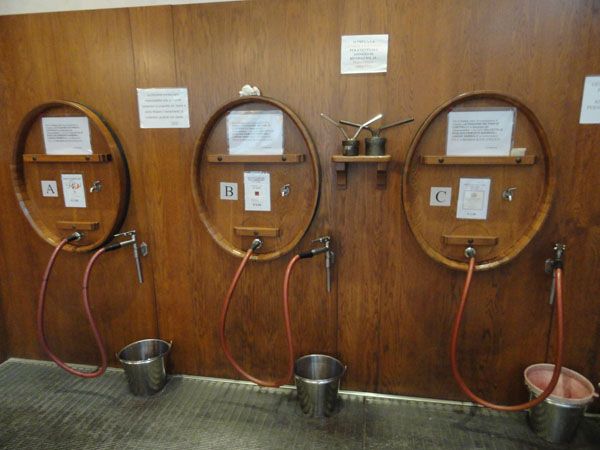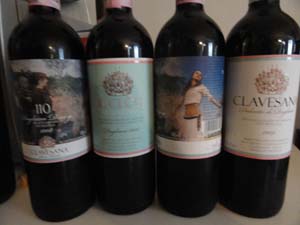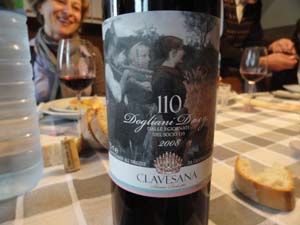Clavesana- Siamo Dolcetto
Clavesana- Siamo Dolcetto
(January 5, 2011)
When They Say "Siamo Dolcetto"- We are Dolcetto - They Really Mean it. Last Year They Sold Over 300,000 Cases of Dolcetto!
Clavesana- Siamo Dolcetto – We are Dolcetto
It was a typical day in Piemonte in early November--fog and rain with a chill in the air as we headed for the town of Clavesana in Dogliani and the Clavesana winery. I was glad that I was not driving; Ernie and Louise DeSalvo joined Michele and I on our trip and did all the driving.
This was very different from the hot June day when I first tasted four Dolcetto’s from the Clavesana winery in a New York City apartment with Anna Bracco, Clavesana’s Director. I liked the wines so much that I told her that next time I was in Piemonte I would visit the winery. This time I was as good as my word. At the winery, Anna introduced us to Giovanni Bracco (no relation) who has been the Clavesana Coop’s president since 1987.
When they say Siamo Dolcetto – We Are Dolcetto -- they really mean it. Last year the coop sold over 300,000 cases of Dolcetto, over 90% in Italy. The Co-op was founded in 1959 by 32 growers and today there are about 340 members.
Anna then told us more about Clavesana. Their logo, she said, features the ten landmark “campanili’ (bell towers) of the towns where the growers (shareholders) live. These are the towns of Dolcetto’s homeland. The keys on the logo are the symbol of the town of Clavesana, which has been named the gateway to the Langhe. Some of the growers have other jobs and can only look after the vineyards part time and their agronomist Carlo Arnufo gives extra help to these growers so they will not feel alone and abandon the land. She went on to say that they are trying to keep young people from leaving the area and the land and are doing everything possible to help them to stay. One such young man was Guiseppe Bracco, the nephew of Giovanni, and we had an excellent lunch with him and his fiancée Fiorella. One of the highlights of the lunch was a quiche topped with shaved white truffles, a first for me; it was a perfect combination with the Dolcetto. In fact the Clavesana Dolcetto went very well with all the local specialties that we had.
 |
 |
 |
Anna made a point of saying that they pay the growers according to the quality of the grapes and will pay them as much as 20% higher than the market price. This she says is another incentive for the growers to produce superior grapes.
Giovanni Bracca explained some of the Italian terms they were using including the idea of “singular-plurality”:
Clavesana’s microvinification is called Vinification alla Giornata, and Allagiornata are the single vineyard Doglianis—Dolcetto DOCG.
Allagiornata – A day’s work from the single vineyards of Clavesana’s stakeholders. When two Piemontese bulls are finished for the day, they have worked one “giornata”, nearly one acre (3,310 meters). This is the root of Clavesana’s singular plurality. He went on to say that even though they are a co-op, some growers bottle wine from a single vineyard. Day in and day out they live “Allagiornata”. They are identified on the label of each bottle by the stakeholder’s number and name. On Google Earth, it is possible to zoom in on the exact location of the vineyard by entering its single vineyards’ coordinates from the label. For example: Giovanni explained that his vineyards are at 571 meters above sea level and his single vineyard wine is 110 Dogliani DOCG delle 3 Giornate di Socio 110 a Calvesana 44º 27’ 59.76” N 7 56’ 54.26’’ E. which we drank when we visited his nephew Giuseppe Bracca for lunch in Pra Del Pozzo one of the ten villages in the heartland of Dolcetto. We also had the 474 Dogliani DOCG 2008 from the 5.5 Giornate of Socio 474 in Clavesana-Marco Beccarai 44º 27’ 42.55’’N 7 55’07.34’’E. I enjoyed this wine at Del Posto in NYC where I was able to discuss it with Clavesana’s oenologist, Roberto Boeri.
Sig. Bracco further explained the difference between the Dolcetto di Dogliani DOC and the Dogliani DOCG. The old winery, the heart of Clavesana, was originally built only with cement tanks. Later, stainless steel tanks were added but mostly on the outside of the winery. Dolcetto di Dogliani 2009 and Piemonte Dolcetto D’H0 2010 were vinified in stainless steel tanks and are left here or transferred to cement tanks for a few months. For these last two wines, there is no minimum aging.
Dogliani DOCG/ Dolcetto di Dogliani Superiore- The DOCG has the lowest yields in liters(wine)/ hectares 4.760 of all the different zones of Dolcetto production in Piemonte. The minimum aging is 12 months from Oct 15 of the year of the grape harvest. The minimum alcohol is 12.5%. It is interesting to note that if vineyard and geographical names are on the label, the yield is reduced to 4284 liters/hectare (wine) and the minimum alcohol content is increased by 0.5%. Il Clou Dogliani DOCG is vinified in stainless steel but is aged in botte grande (large oak barrels of oak 50hl).
Allagiornata Dogliani DOCG (Socio 110 for example) are the only ones vinified in cement. The length of time depends on the vintage, 4/6months
Dolcetto di Dogliani DOC – With geographical and vineyard names on the label the yields are reduced to 5040 liters/hectare (wine) and natural alcohol content is increased by 0.5%. All of the wine is made from 100% Dolcetto grapes
The name Dolcetto means sweet little one but the wine is dry. It has medium alcohol, tannin and a deep ruby red color. They can be light wines fresh and fruity like the “D’HO” Piemonte Dolcetto DOC 2010 that are meant to be drunk young and has written on the label “You D’HO Something TO ME” Or they can be full bodied and well structured like the “Il Clou” Dogliani DOCG 2008, aged for a short time in botte and the Allagiornata vinified in cement and aged in botte grande that can age for several years. All of this depends on the area of cultivation and how the grapes are vinified in the winery.
Dolcetto is 90% of their total production, though Clavesana also makes other wines. When we were taking a tour of the winery Giovanni Bracco said that they were experimenting with different woods for aging wine. He pointed out 500 liter barrels made from local acacia wood that was aging Nebbiolo from the 2009 vintage to be made into Barolo. They also were experimenting with local oak.
Giovanni Bracco offered us a taste of the “Vino Sfuso”, a wine that the local’s buy. They bring in large plastic bottles and fill them from a barrel that had a hose attached. The wine is very young and very inexpensive but both Ernie and I liked it. We were told it was the same wine that they bottled, but this way they could sell it for less.
I have heard it said that the best Dolcetto comes from the Dogliani zone and after tasting and drinking the Dolcetto from Clavesana I agree. Even their “D’HO which is a Piemonte DOC (meaning the grapes can come from any Dolcetto area) is a bargain at $10.99 as is the Dolcetto di Dogliani. The Dogliani DOCG, both the regular and single vineyard, are a great buy at $16.99.
This work may not be reproduced, in whole or in part, without prior written permission.
Questo lavoro non può essere riprodotto, in tutto o in parte, senza permesso scritto.



